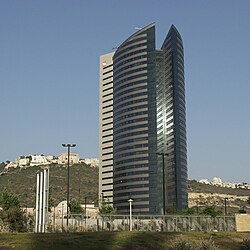Israel Electric Company
 |
|

IEC Tower, company's headquarters
|
|
| Government-owned corporation | |
| Industry | Electric utilities |
| Founded | 1923 |
| Founder | Pinchas Rutenberg |
| Headquarters | Haifa, Israel |
|
Area served
|
Israel |
|
Key people
|
Yiftah Ron-Tal (Chairman since 2011) Ofer Bloch (CEO) |
| Products | Electricity generation, transmission and distribution |
| Revenue | ₪ 27.7 billion (2013) |
| ₪ 1.4 billion (2013) | |
| ₪ (808) million (2013) | |
|
Number of employees
|
9,782 permanent employees 2,894 temporary employees |
| Website | iec.co.il |
Israel Electric Corporation (Hebrew: חברת החשמל לישראל, abbreviation: IEC) is the largest supplier of electrical power in Israel. The IEC builds, maintains, and operates power generation stations, sub-stations, as well as transmission and distribution networks.
The company is the sole integrated electric utility in the State of Israel. Its installed generating capacity represents about 75% of the total electricity production capacity in the country. It transmits and distributes substantially all the electricity used in Israel, including power generated by other producers. The State of Israel owns approximately 99.85% of the company.
After British forces conquered Palestine, they had to deal with conflicting demands rooted in Ottoman rule. For example, on 27 January 1914, the city of Jerusalem had granted a Greek citizen, Euripides Mavromatis, concessions for the supply of water, electricity, and the construction of a tramway system in the city. Work under these concessions had not begun and by the end of the war the British occupying forces refused to recognize their validity.
On 12 September 1921, the British formally signed the “Auja (or Yarkon) Concession” which granted Pinhas Rutenberg's Jaffa Electric Company a 70-year concession granting it exclusive rights to generate, distribute, and sell electricity in the administrative District of Jaffa, and authorized Rutenberg to generate electricity by means of hydroelectric turbines that would exploit the water power of the Auja (Yarkon) river. However, Mavromatis challenged the concession claiming that his concessions conflicted with the Auja Concession and that he was being deprived of his legal rights. The Mavromatis concessions, in effect despite earlier British attempts to abolish it, covered Jerusalem and other localities (e.g., Bethlehem) within a radius of 20 km (12 miles) around the Church of the Holy Sepulchre. In the end, Rutenberg's company concessions remained and the company built a power plant that produced electricity using diesel-fueled engines, and by 1923 Jaffa Electric Company's grid covered Jaffa, Tel-Aviv, neighboring (mainly Jewish) settlements, and the British military installations in Sarafend.
...
Wikipedia
